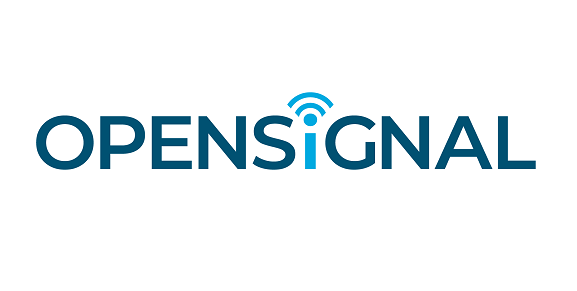ประสบการณ์การใช้งาน 5G บนโทรศัพท์มือถือมีการเปลี่ยนแปลงอย่างต่อเนื่องจากความต้องการใช้งาน 5G ของผู้ใช้สมาร์ทโฟนที่เพิ่มขึ้นและการพัฒนาเครือข่าย 5G ของผู้ให้บริการต่าง ๆ จากมุมมองของผู้ใช้ Opensignal พบว่าภูมิภาคเอเชียแปซิฟิก (APAC) มีคุณภาพประสบการณ์การใช้งาน 5G สูงสุดเท่าที่เคยเห็นมา อย่างไรก็ตามในแต่ละตลาดยังมีความแตกต่างกันอย่างมาก โดยขึ้นอยู่กับระยะเวลาการเปิดใช้ 5G และประเภทของคลื่นความถี่ไร้สายที่ผู้ให้บริการเปิดใช้กับเครือข่าย 5G
จากการวิเคราะห์ล่าสุดของ Opensignal ประเทศเกาหลีใต้และไต้หวันนับเป็นคู่แข่งที่สูสีในด้านประสบการณ์การใช้งาน 5G โดยเกาหลีใต้มีความเร็วในการดาวน์โหลด 5G เฉลี่ยสูงสุดอยู่ที่ 380.5 Mbps ส่วนไต้หวันพบว่ามีความเร็วในการดาวน์โหลด 5G ที่จุดสูงสุด (847.3 Mbps) และความเร็วในการอัปโหลด 5G เฉลี่ย (51.8 Mbps) แซงหน้าเกาหลีใต้เล็กน้อย
สำหรับประเทศสิงคโปร์นั้นมีความเร็วในการดาวน์โหลด 5G อยู่ในระดับกลางของกลุ่มเอเชียแปซิฟิกเนื่องจากการเพิ่งเริ่มให้บริการ 5G ในช่วงครึ่งปีหลัง 2563 ซึ่งเป็นเรื่องน่าสนใจสำหรับประเทศสิงคโปร์เพราะผู้ให้บริการมีคลื่นความถี่ 5G ย่านกลางที่จำกัดมากกว่าผู้ให้บริการในประเทศอื่น ๆ ทั้งยังมีปัญหาด้านการนำคลื่นความถี่หลากหลายมาใช้ร่วมกันที่เป็นความท้าทายหลักของประเทศ ซึ่งเกิดจากประเทศเพื่อนบ้านใช้คลื่นความถี่ย่าน 3.5 GHZ ในการให้บริการทีวีดาวเทียมแบบยิงตรงถึงบ้านและการใช้บริการมือถือในย่านความถี่นี้อาจทำให้เกิดการรบกวนได้
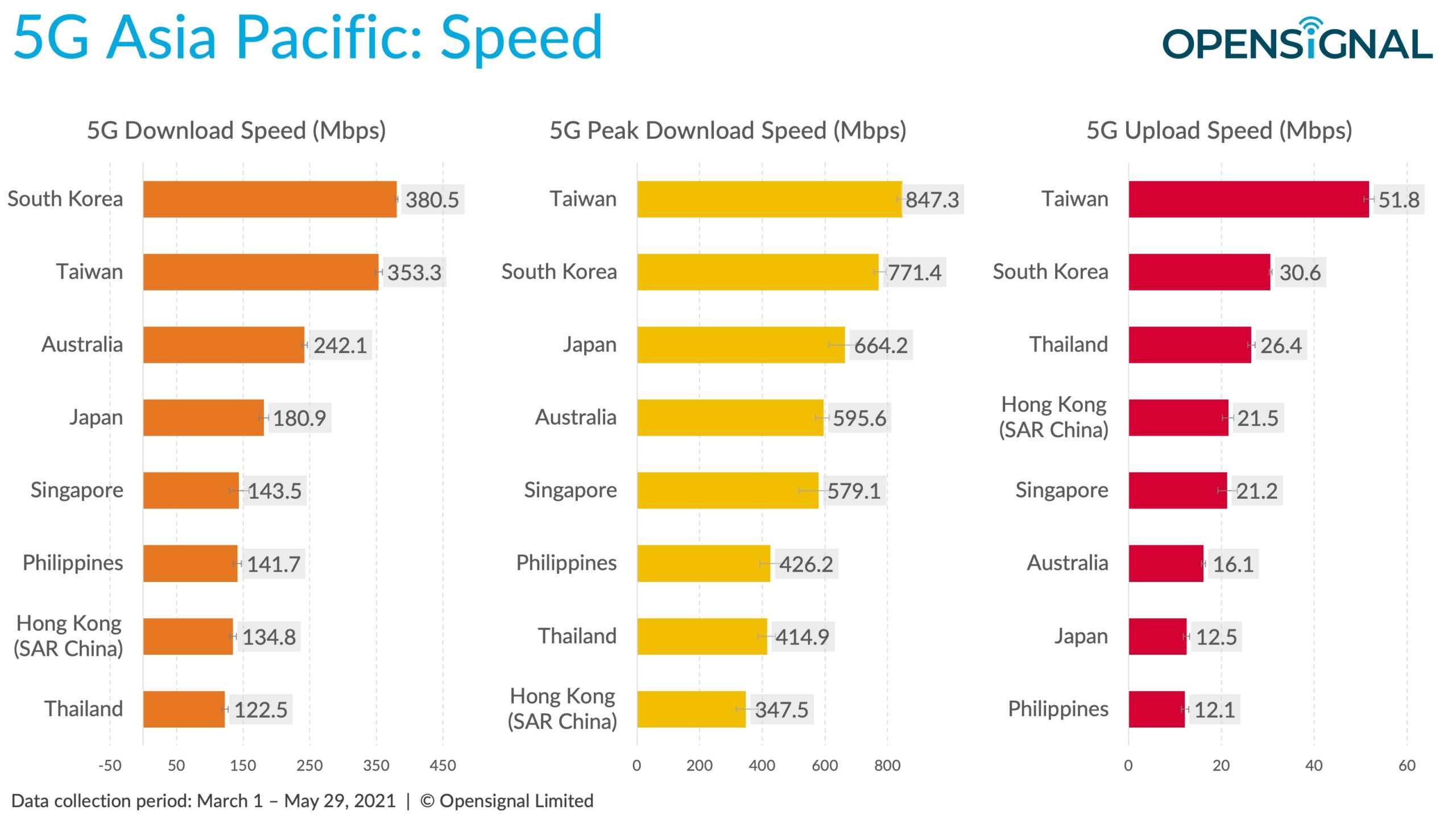
ผู้ใช้สมาร์ทโฟนต้องการใช้เครือข่าย 5G เพื่อพัฒนาประสบการณ์ในการใช้แอปพลิเคชันในโทรศัพท์มือถือ เมื่อเราเปรียบเทียบวิดีโอที่เปิดใช้งานด้วยเครือข่าย 5G รวมถึงการเล่นเกมแบบมัลติเพลเยอร์และประสบการณ์ที่ได้รับผ่านแอปสื่อสารด้วยเสียงยอดนิยมต่าง ๆ ทำให้เห็นถึงผลลัพธ์ด้านความเร็วที่แตกต่างกันอย่างมาก
ตัวอย่างเช่น ประเทศสิงคโปร์อยู่อันดับสองด้านประสบการณ์เกม 5G ตามหลังประเทศชั้นนำด้านเกมอย่างเกาหลีใต้มาติด ๆ ส่วนประเทศไทยนั้นขยับขึ้นจากเดิม 4 อันดับ ในด้านประสบการณ์วิดีโอ 5G ซึ่งสูงกว่าอันดับด้านความเร็วในการดาวน์โหลด 5G เช่นเดียวกับ ฮ่องกง ที่ขยับขึ้นมาอยู่ในอันดับที่ 3 ตรงกันข้ามกับประเทศญี่ปุ่นที่ประสบการณ์ 5G ยังพัฒนาได้ไม่เต็มที่็ทำให้ตกอันดับลง
นอกจากนี้ Opensignal ยังพบว่าทุกประเทศในเอเชียแปซิฟิกได้รับประสบการณ์วิดีโอ 5G อยู่ในระดับยอดเยี่ยม (75 ขึ้นไป) ส่วนในด้านประสบการณ์เกม 5G ในสองประเทศเกาหลีใต้และสิงคโปร์ได้รับคะแนนในระดับยอดเยี่ยม อีกทั้งผู้ใช้ในอีก 4 ประเทศ ได้แก่ ไต้หวัน ฮ่องกง ประเทศไทย และออสเตรเลีย ยังได้รับประสบการณ์เกม 5G อยู่ในระดับดี (75<85) ความแตกต่างระหว่างการวัดค่าทั้งสองนี้ทำให้เห็นได้ถึงความสำคัญของการปรับใช้ 5G เวอร์ชันใหม่รวมถึงการเข้าถึงเครือข่ายในแบบสแตนด์อโลน (SA) ที่มีจุดประสงค์เพื่อปรับปรุงประสบการณ์เวลาแฝง (Latency) และการตอบสนองในด้านประสบการณ์มือถือ
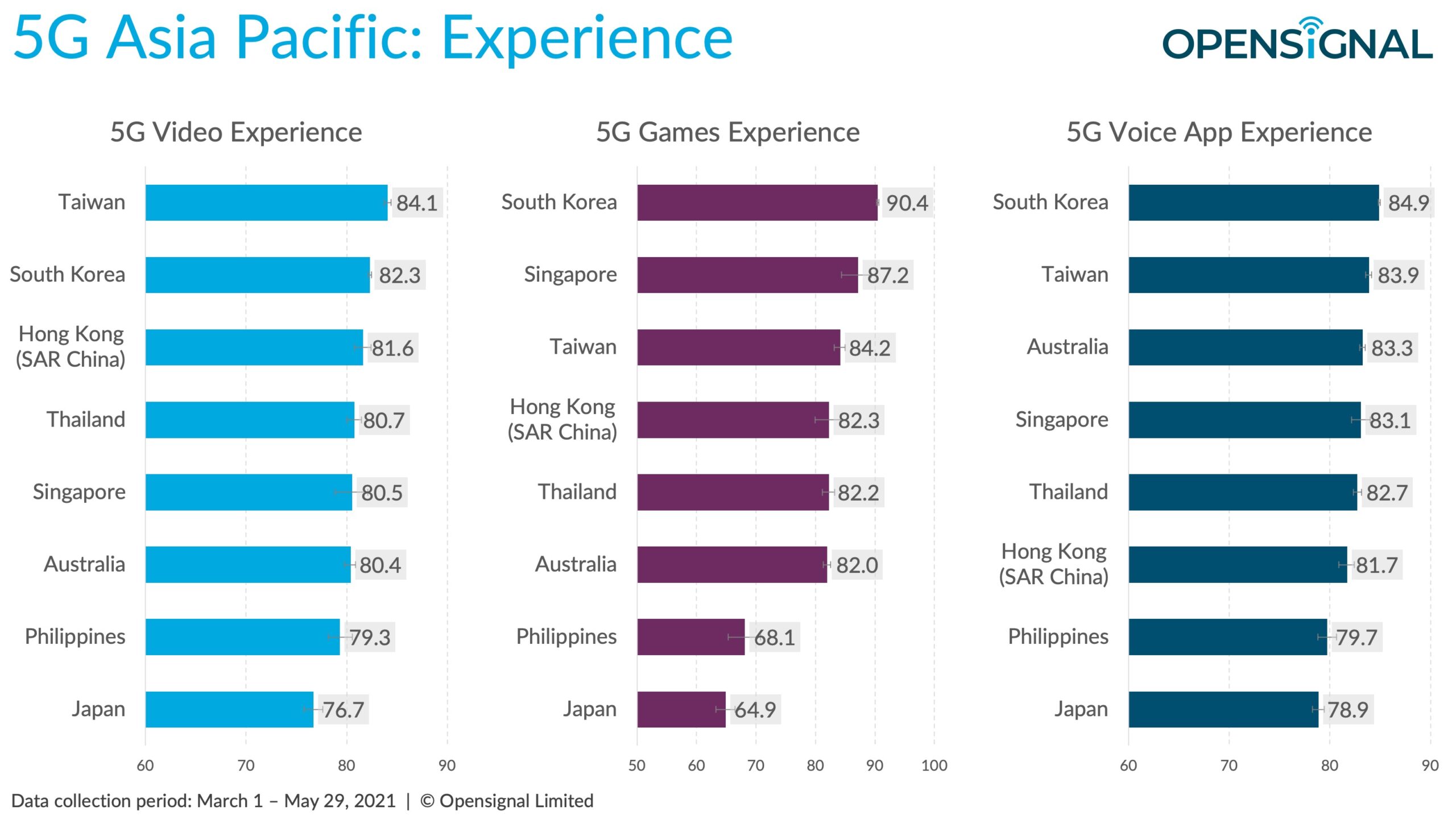
ความเร็วเฉลี่ยในการดาวน์โหลด 5G ในทุกประเทศของเอเชียแปซิฟิกมีความเร็วขึ้นมากอย่างเห็นได้ชัดเมื่อเทียบกับการใช้เทคโนโลยีเครือข่าย 4G โดยต่างกันอย่างน่าประหลาดใจถึง 10.4 เท่าในประเทศฟิลิปปินส์และไต้หวัน และ 2.9 เท่าในประเทศสิงคโปร์
และนี่ยังเป็นการเปรียบเทียบกันระหว่างเวอร์ชั่นแรกของเทคโนโลยี 5G กับเวอร์ชันล่าสุดของเทคโนโลยี 4G ที่ได้รับการพัฒนาอย่างต่อเนื่องมาเป็นเวลา 10 ปี นับตั้งแต่เปิดตัวเครือข่าย 4G ครั้งแรกในปี 2552/53 ในอีก 10 ปีข้างหน้า 5G จะพัฒนาขึ้นพร้อมทิ้งห่างช่องว่างในด้านประสบการณ์ 5G บนมือถือกับเครือข่ายเวอร์ชันก่อน ๆ มากขึ้น โดยเฉพาะอย่างยิ่ง เมื่อผู้ให้บริการเครือข่ายปรับใช้เทคโนโลยี mmWave 5G ให้กว้างขึ้นในภูมิภาค
เราได้เห็นการปรับปรุงขึ้นพอประมาณสำหรับประสบการณ์วิดีโอ 5G โดยมี 4 ประเทศที่มีประสบการณ์วิดีโอ 5G ดีขึ้นกว่าประสบการณ์วิดีโอ 4G มากกว่า 10% ส่วนอีก 2 ประเทศมีการปรับปรุงพัฒนามากกว่า 5% ทั้งในด้านประสบการณ์ความเร็วในการดาวน์โหลดและอัปโหลดวิดีโอแบบ 5G โดยผู้ใช้สมาร์ทโฟนในประเทศฟิลิปปินส์ได้รับประสบการณ์การใช้งานที่ดีขึ้นเป็นอย่างมาก
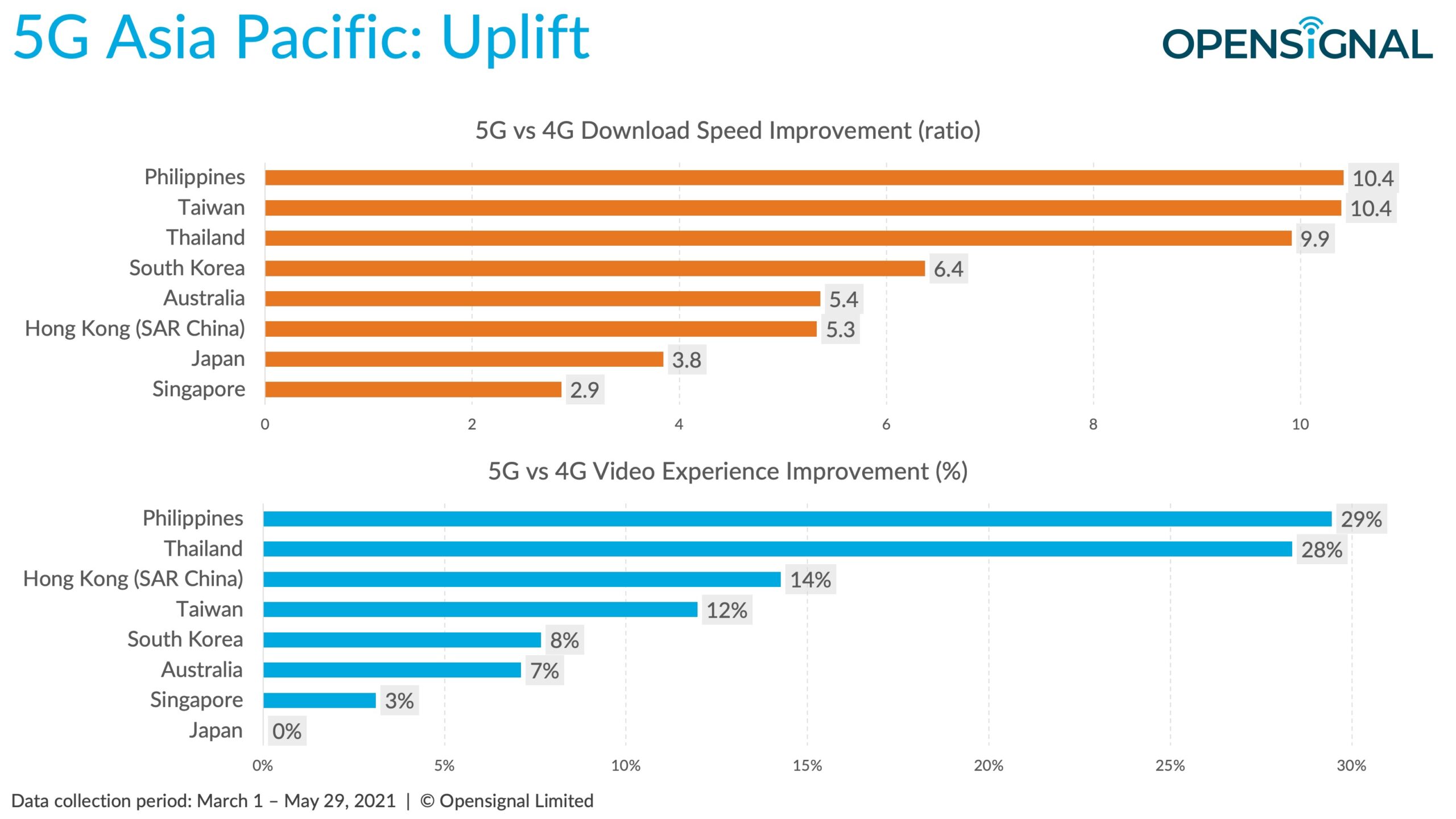
Opensignal เปรียบเทียบเครือข่าย 5G โดยใช้การวัดค่าสองแบบคือ สัดส่วนของเวลาที่ผู้ใช้เชื่อมต่อกับการให้บริการ 5G (ความพร้อมใช้งาน 5G) และสัดส่วนของสถานที่ที่ผู้ใช้งานได้รับประสบการณ์การเชื่อมต่อ 5G (การเข้าถึง 5G) ผลลัพธ์ออกมาไม่เป็นที่น่าแปลกใจนักที่ผู้ชนะอันดับหนึ่งในตารางของประสบการณ์ทั้งสองด้านเป็นของฮ่องกง และยิ่งไปกว่านั้น ผู้ใช้ของ Opensignal ในเกาหลีใต้ใช้เวลาเชื่อมต่อ 5G ในเวลาแทบเท่ากันกับชาวฮ่องกงในเชิงสถิติและยังสามารถพบเจอสัญญาณ 5G ในสัดส่วนที่ไม่ห่างกันมากนักโดยคิดเป็นคะแนนด้านการเข้าถึง 5G ที่ 5.8 จาก 10 คะแนนเทียบกับฮ่องกงที่ 6.2 คะแนน
คะแนนด้านความพร้อมใช้งาน 5G และการเข้าถึง 5G ที่ยังต่ำของประเทศญี่ปุ่นนั้นทำให้เห็นถึงความเชื่อมโยงในด้านความไม่เสถียรของประสบการณ์การใช้งาน 5G ในประเทศญี่ปุ่นเองและยังเป็นตัวช่วยอธิบายถึงคะแนนประสบการณ์วิดีโอ 5G ประสบการณ์เกม 5G และประสบการณ์แอปสื่อสารด้วยเสียง 5G ในประเทศญี่ปุ่นได้อีกด้วย ขณะที่ผู้ให้บริการเครือข่ายของญี่ปุ่น 3 ค่ายได้เปิดให้บริการ 5G ในช่วงกลางปี 2563 และรายที่ 4 เปิดให้บริการในช่วงปลายปีเดียวกันนั้น ทำให้ความครอบคลุมของสัญญาณยังไม่กว้างขวางนัก
อย่างไรก็ตามผู้ให้บริการในประเทศญี่ปุ่นทุกรายต่างให้ความสำคัญกับการขยายพื้นที่สัญญาณ 5G ในช่วง 18 เดือนนี้โดยเริ่มตั้งแต่ไตรมาสแรกของปี 2564 (คลิกดูเพิ่มเติมที่ au/KDDI, NTT DoCoMo, SoftBank และ Rakuten) แต่ยังเร็วเกินไปที่จะเห็นผลลัพธ์ของการพัฒนา นอกจากนี้ทั้งฟิลิปปินส์และออสเตรเลียยังมีผลคะแนนด้านประสบการณ์เป็นที่น่าพอใจด้วยพื้นที่ทางภูมิศาสตร์ที่ใหญ่กว่า ผู้ใช้งาน 5G ของ Opensignal ในตลาดทั้งสองแห่งนั้นใช้เวลาในการเชื่อมต่อ 5G คิดเป็น 10% และได้รับประสบการณ์ 5G เกือบหนึ่งในสาม ครอบคลุมพื้นที่ี่ต่าง ๆ พร้อมมีคะแนนการเข้าถึง 5G ที่ 3.0 และ 2.9 ตามลำดับ
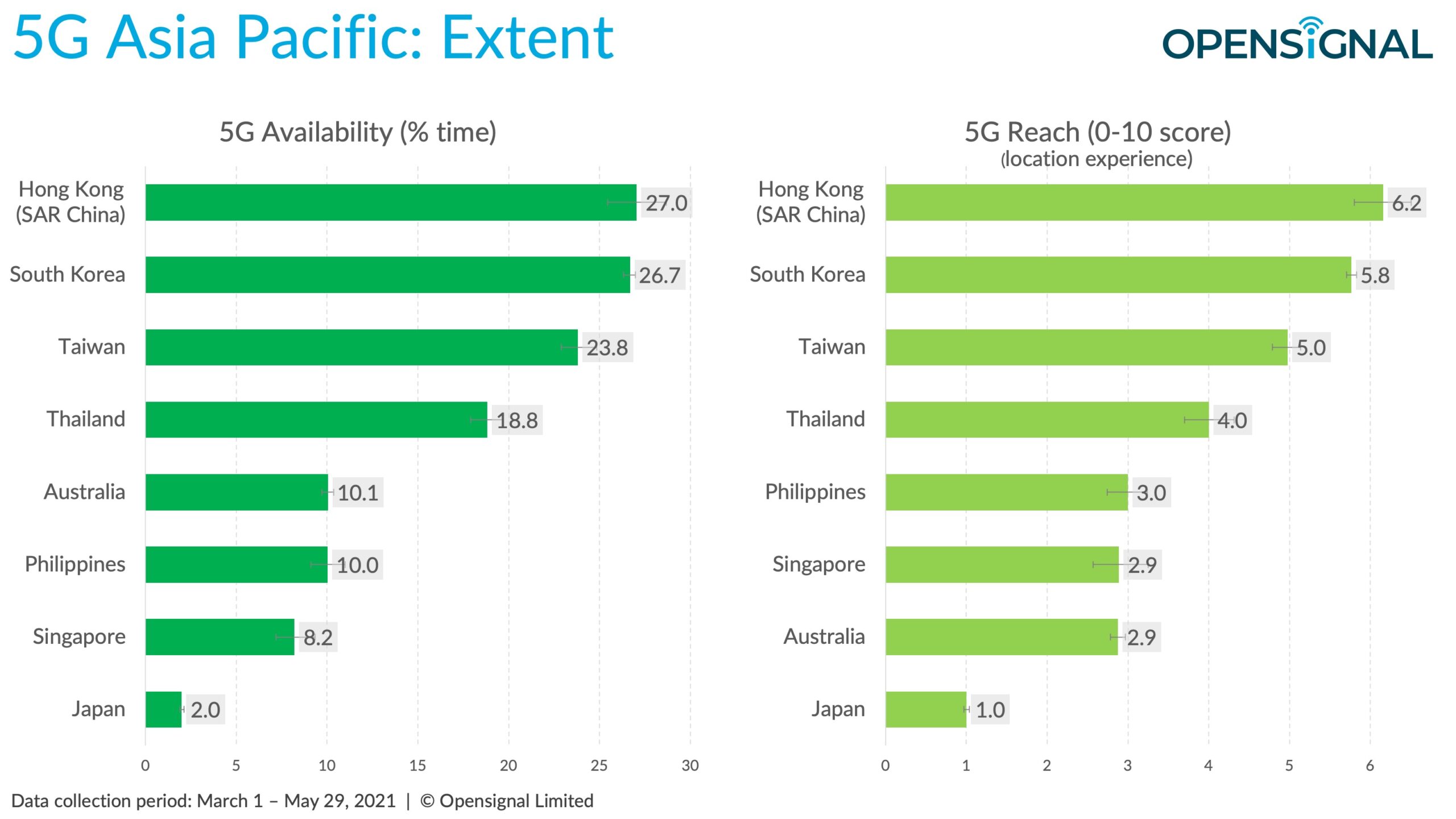
ผู้ให้บริการประเทศอื่น ๆ ในแถบเอเชียแปซิฟิกก็มีการเปิดให้ใช้งาน 5G เช่นเดียวกัน รวมทั้งประเทศนิวซีแลนด์และอินโดนีเซีย Opensignal จะวิเคราะห์เกี่ยวกับความก้าวหน้าของ 5G ในทุก ๆ ตลาดอย่างต่อเนื่องรวมไปถึงตลาดอื่น ๆ เพิ่มเติมเกี่ยวกับ 5G เชิงลึกในอนาคต
บทความอื่น ๆ ที่เกี่ยวกับการวิเคราะห์ 5G เพิ่มเติมจาก Opensignal:
